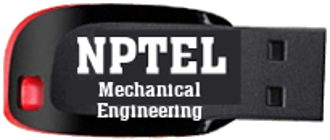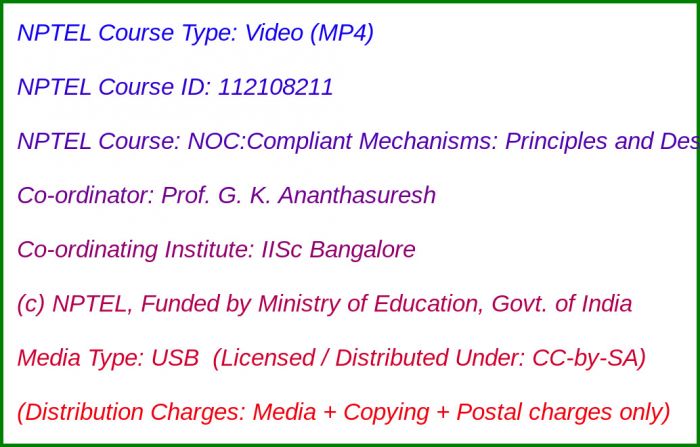NOC:Compliant Mechanisms: Principles and Design (USB)

Media Storage Type : 32 GB USB Stick
NPTEL Subject Matter Expert : Prof. G. K. Ananthasuresh
NPTEL Co-ordinating Institute : IISc Bangalore
NPTEL Lecture Count : 72
NPTEL Course Size : 16 GB
NPTEL PDF Text Transcription : Available and Included
NPTEL Subtitle Transcription : Available and Included (SRT)
Lecture Titles:
Lecture 1 - Overview
Lecture 2 - Spirit of compliant design
Lecture 3 - A glimpse of applications
Lecture 4 - Mobility and degrees of freedom in compliant mechanisms
Lecture 5 - Maxwell’s rule and Grübler’s formula
Lecture 6 - Using compatibility and force equilibrium matrices to identify degrees of freedom and states of self-stress in trusses
Lecture 7 - Empirical formula for flexure joints
Lecture 8 - Types of elastic pairs (flexures)
Lecture 9 - Linear finite element analysis of compliant mechanisms with beam elements
Lecture 10 - A compliant mechanism kit
Lecture 11 - Linear and nonlinear finite element analyses using continuum elements
Lecture 12 - Subtleties in finite element analysis: geometric nonlinearity and contact
Lecture 13 - Deformation of a cantilever under a tip-load, using elliptic integrals
Lecture 14 - Elliptic integrals and their use in elastica analysis
Lecture 15 - Frisch-FayÂ’s approach to large deformation of beam
Lecture 16 - Burns-CrossleyÂ’s kinematic model
Lecture 17 - Howell-MidhaÂ’s elastic model
Lecture 18 - Putting together the pseudo rigid-body model
Lecture 19 - Modeling a partially compliant mechanism
Lecture 20 - Kinematic coefficients of a four-bar linkage with and without springs
Lecture 21 - Solving equations of PRB modeling and comparing with finite element analysis
Lecture 22 - Loop-closure equations for PRB models of compliant mechanisms
Lecture 23 - Burmester theory for compliant mechanisms
Lecture 24 - PRB-based Synthesis Examples
Lecture 25 - Structural optimization approach
Lecture 26 - Early works on design for compliance
Lecture 27 - Design for deflection of trusses
Lecture 28 - Design for deflection of beams and frames
Lecture 29 - Design of elastic continua for desired deflection
Lecture 30 - Continuum element-based topology optimization of compliant mechanisms
Lecture 31 - YinSyn; synthesis of nonlinear responses with compliant mechanisms
Lecture 32 - Five different formulations for compliant mechanism design and some benchmark problems
Lecture 33 - Distributed compliance
Lecture 34 - How to achieve distributed compliance
Lecture 35 - Shape optimization
Lecture 36 - Cam-flexure clamp-case-study
Lecture 37 - SL model for compliant mechanisms
Lecture 38 - Feasibility maps for compliant mechanisms
Lecture 39 - Selection of compliant mechanisms for given user-specifications
Lecture 40 - Two case-studies using feasibility maps technique
Lecture 41 - SML model for compliant mechanisms for dynamic response
Lecture 42 - Re-design of compliant mechanisms; Matlab and Java codes
Lecture 43 - Non-dimensional analysis of beams
Lecture 44 - Deformation index and slenderness ratio of compliant mechanisms
Lecture 45 - Kinetoelastostatic maps
Lecture 46 - Designing with kinetoelastic maps
Lecture 47 - Non-dimensinalization of stress, frequency, and other measures
Lecture 48 - Designing compliant suspensions using kinetoelastic maps
Lecture 49 - Instant centre method for designing compliant mechanisms
Lecture 50 - Stiffness and compliance ellipsoids
Lecture 51 - Building block method of designing compliant mechanisms
Lecture 52 - Comparative analysis of different methods for designing compliant mechanisms
Lecture 53 - Aspects of Mechanical advantage of compliant mechanisms
Lecture 54 - Mechanical advantage of rigid-body and compliant mechanisms
Lecture 55 - Bistability in elastic systems
Lecture 56 - Analysis of bistable arches
Lecture 57 - Compliant mechanisms with bistable arches
Lecture 58 - Static balancing and zero-free-length springs
Lecture 59 - Static balance of a compliant mechanism using a linkage
Lecture 60 - Static balancing method for compliant mechanisms
Lecture 61 - A catalogue of compliant mechanisms
Lecture 62 - Compliant suspension mechanism in microsystems (MEMS)
Lecture 63 - Micromechanical signal processors using compliant mechanisms
Lecture 64 - A few special concepts of compliant mechanisms
Lecture 65 - Materials and prototyping of compliant mechanisms
Lecture 66 - Summary of the course
Lecture 67 - Micromachined accelerometers with Displacement-amplifying Compliant Mechanisms (DaCMs)
Lecture 68 - Miniature compliant mechanisms as cell-manipulation tools
Lecture 69 - Micro-newton force sensor
Lecture 70 - Compliant tissue cutting mechanism
Lecture 71 - A compliant pipe-crawling robots
Lecture 72 - A compliant easy-chair for the elderly

